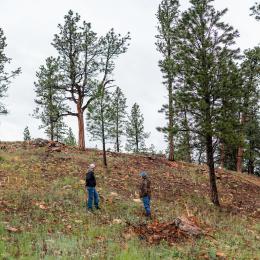After the Fire - Hillside Home Damage
Drainage tips for homeowners of hillside lots that have been damaged by fire or are in a fire-damaged watershed.
Hillside lots that have been damaged by fire or are in a fire-damaged watershed can be susceptible to erosion, drainage, and other surface water (runoff)-related problems. Torrential or prolonged rains can cause the most damage, but even lighter rains within a fire-damaged watershed can generate greater than expected runoff. To treat surface drainage problems, first identify the sources of runoff flowing onto or over your property. Walk outside and around your home. As you walk, observe the “lay” of your lot and the surrounding properties. Also, observe how runoff patterns might be influenced by your roof, foundation, and driveway. Is your lot on top of a hill where all runoff naturally drains away from your home? If so, you should likely be most concerned about preventing soil loss from your property. If, like many homeowners, you do not live on top of a hill, it is more likely that runoff will flow onto your property from an adjacent hillside or drainage way. Where will the runoff concentrate and how can you control soil, rock, or debris carried with the water?
Gutters and downspouts direct roof runoff
Be sure that your roof is properly fitted with gutters and downspouts that will release water onto a non-erodible surface such as a paved driveway. Alternatively, you can connect downspouts firmly to solid plastic pipe that will carry water down slope away from your home to a stable outlet such as a paved roadside or storm drain ditch. Because twigs, pine needles and leaves can clog gutters and downspouts, secure hardware cloth with 1/4 to 1/2-inch openings along gutter tops. Clear your gutters regularly and inspect them to ensure your roof runoff system is working properly.
Curbs and berms protect sensitive slopes
A concrete curb, compacted earth berm, or other similar structures constructed on the outside edge of a driveway or building pad can direct runoff away from sensitive slopes to a stable outlet. A recommended minimum berm height is 12-18 inches but may need to be higher in locations where larger volumes of runoff, soil, rock, or debris could concentrate. Pipe or other structures may be used to carry runoff down slope to a stable outlet, such as a lined roadside ditch or storm drain.
Lined ditches handle road and driveway runoff
Roads and driveways can be graded toward a lined ditch or street side gutter designed to handle concentrated runoff. At intervals along these drainage features, water can be removed from the main flow, transported under the adjacent road through a culvert and released at a stable outlet, such as a rock lined channel, to prevent erosion. In steeper areas or where larger volumes of runoff concentrate, other measures may be needed to prevent washouts or localized flooding.
Proper grading promotes good drainage
Proper grading of your land helps prevent water from pooling around foundations, flooding basements or below grade structural components, and concentrating runoff into destructive volumes. In general, grade surfaces around a home so runoff flows away from foundations at a minimum slope of 6 inches in the first 10 feet. Grade and compact surfaces evenly since runoff can collect in depressions or channelize into destructive flows.

"CAUTION: After a fire, many trees are weakened from burning around the base of the trunk. These trees can fall over or blow down without warning. Shallow-rooted trees can also fall. Therefore, be extremely alert around burned trees.
Additional Information
Montana Forestry Resources
NRCS Montana guides for forest management and wildfire recovery.
NRCS Forestry Web Page
Forestry and agroforestry information and technical resources that apply to all States.


